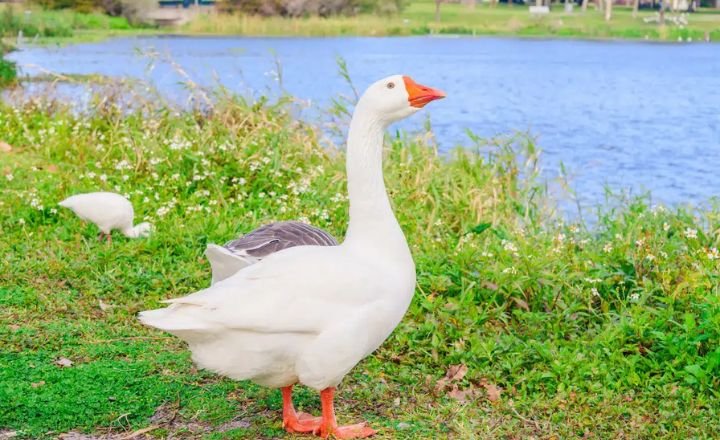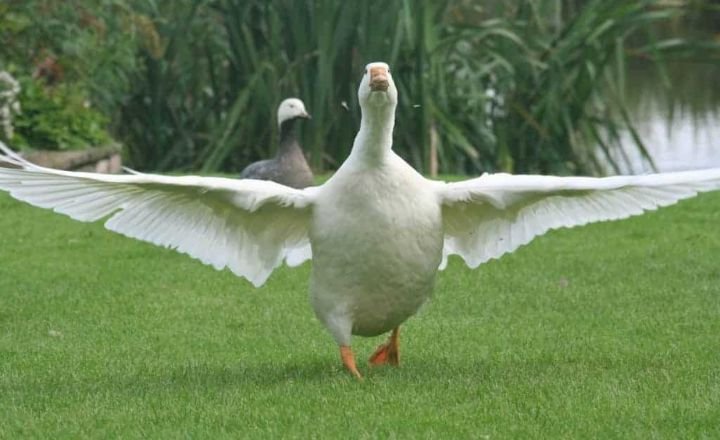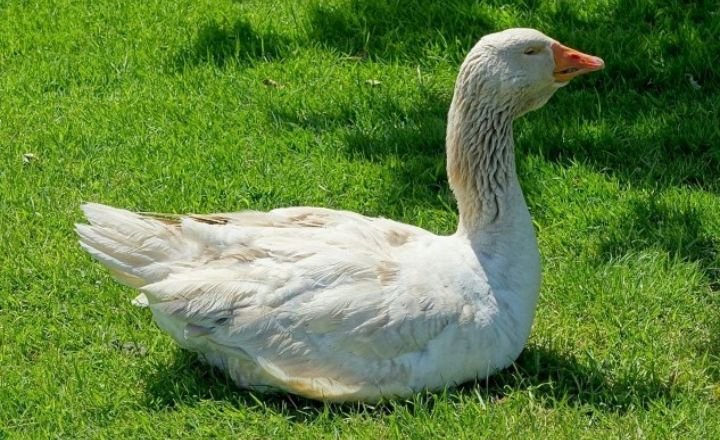The world of poultry, the elegant white goose stands out as a symbol of grace and beauty. With their pristine plumage and regal presence, white geese have captivated farmers and enthusiasts alike for centuries. But behind their stunning appearance lies a rich history and diverse range of breeds, each with its own unique characteristics and traits.
From the majestic Embden to the charming Toulouse, white geese breeds offer a fascinating glimpse into the world of aviculture. These magnificent birds have not only been prized for their ornamental value but also valued for their practical contributions to agriculture.
White Geese Breeds
- Snow geese
- Sebastopol geese
- Embden geese
- Roman geese
- American buff geese
- White Pomeranian geese
- White Chinese geese
- Danish landrace geese
Snow Geese
The striking contrast of white and black adorning the snow goose’s plumage serves as a visual delight, making them easily recognizable in their flocks. Their affinity for socialising with other geese species reflects their communal nature and enhances the beauty of their shared habitats.
The females’ strong attachment to their birthplace not only showcases their loyalty but also highlights the importance they place on maintaining tradition in their colonies. Nesting and living in colonies, snow geese prefer high ground for their modest abodes during the breeding season from May to August.
- Average height: 64 to 79 centimetres
- Average weight: 6 lbs
- Life span: 15 years
- Prominent feature: Black wingtips, philopatric
Sebastopol Geese
Sebastopol geese, with their ethereal beauty and unique appearance, truly stand out among other goose breeds. The heavy, frizzled feathers cascading in milky white plumage give them a regal and striking presence that captures the attention of all who see them.
Despite their inability to fly due to their curvy feathers, Sebastopol geese compensate with their graceful waddling gait that adds to their charm. In Germany, they are known by various colourful names like Lockengans or struppagans, these elegant geese are not just prized for their looks but also for their docile and amiable nature.
Their role as tyes of pets or ornamental birds is enhanced by their friendly disposition and forgiving demeanour towards humans. Despite being valued for both pleasure and practical purposes like meat production and egg-laying, it’s important to note the need for attentive care and protection during harsh weather conditions due to their less hardy nature compared to other breeds.
- Average height: 110 centimetres
- Average weight: 10 lbs
- Lifespan: 25 years
- Prominent feature: Frizzled, long, and curvy feathers
Embden Geese
The unique characteristics of Embden geese make them a fascinating breed to observe and care for. Their striking white plumage, graceful curved necks, and vibrant orange feet give them an elegant appearance reminiscent of swans.
Despite their gentle nature, they often fall prey to bullying from other more assertive geese breeds due to their calm demeanour. Their rapid growth rate and impressive weight gain make them a popular choice for meat production among farmers.

The ability to lay up to sixty eggs per year, Embden geese also provide a valuable source of nutritious eggs. Their distinct blue eyes and short tails add to their overall charm, making them a visually appealing addition to any farm or homestead.
These ancient domesticated birds not only offer practical benefits but also bring beauty and tranquillity to their environment with their serene presence.
- Average height: 3.3 feet
- Average weight: 41 lbs
- Lifespan: 24 years
- Prominent feature: Long curved neck
Roman Geese
The Roman goose, with its elegant all-white plumage and small stature, stands out as a unique and charming breed. Despite their modest egg-laying capabilities, these geese excel in reaching maturity quickly and providing a meaty carcass. Their fine-boned structure and compact body make them a delightful addition to any farm or homestead.

What truly sets the Roman goose apart is their endearing personality – they are not only watchful watchdogs but also form strong bonds with their human companions in record time. As keepers of Roman geese, it is crucial to be mindful of potential genetic defects that can affect the offspring.
Issues such as kinked necks, wry tails, and crooked toes require special care and attention to ensure the health and well-being of these beloved birds.
Despite these challenges, the beauty of their uniform bodies, plump breasts, and alert demeanors make caring for Roman geese a rewarding experience that fosters a deep connection between animal and owner.
- Average height: 45 inches
- Average weight: 10 lbs
- Lifespan: 25 years
- Prominent feature: Bulky breast, rounded body
American Buff Geese
The American buff goose, with its unique colouring and distinctive features, holds a special place in the world of poultry. Their apricot–fawn coloration and buff creamy edged feathers set them apart from other breeds, making them a visually striking addition to any farm or homestead.

Despite their beauty, the American buff goose faces the looming threat of extinction due to their scarcity and dwindling numbers in recent years. A versatile bird that is raised for both meat and eggs, American buff geese play an important role in sustainable agriculture practices.
Their ability to forage efficiently and adapt well to various environments make them valuable assets on small farms looking to diversify their livestock offerings.
- Average height: 45 inches
- Average weight: 18 lbs
- Lifespan: 25 years
- Prominent feature: Pale pink nails, creamy feathers, apricot-fawn, and white colour blend
White Pomeranian Geese
The heavy, medium-sized Pomeranian geese are not only prized for their prolific egg-laying abilities but also for their succulent meat. With an impressive average of fifteen to thirty-five eggs per year, these geese are highly productive and valuable to their keepers.
The striking contrast between the white plumage of the adults and the yellow hue of their young ones adds an element of visual appeal to this breed. Known for their noisy nature, Pomeranian geese are vocal creatures that can make quite a ruckus.
Their distinct calls serve as both a welcoming gesture and a means of communication within their flock. While some individuals may exhibit friendly and sociable behaviours, others may display aggression towards humans and other birds.
This complexity in temperament adds an intriguing layer to the dynamics within the species.
- Average height: 40 inches
- Average weight: 17 lbs
- Lifespan: 24 years
- Prominent feature: Social and chatty
White Chinese Geese
White Chinese geese are not just visually stunning with their all-white plumage, but they also serve as efficient egg producers. Their large size and distinct basal knob make them a unique addition to any farm or poultry operation.
The presence of the knob not only adds to their charm but also serves as a practical characteristic for sex determination. One fascinating aspect of white Chinese geese is their strong affinity for water. Without access to water, these geese cannot thrive, making it essential for farmers to ensure a constant supply on hand.
This dependency on water showcases the breed’s natural habitat preferences and aligns with their biological needs for hydration and grooming.
Whether you’re raising them for eggs or simply enjoying their graceful presence in your flock, white Chinese geese offer both aesthetic appeal and practical benefits that speak to their resilience and adaptability in various farming environments.
- Average height: 43 inches
- Average weight: 20 lbs
- Lifespan: 40 years
- Prominent feature: Good egg layer, Prominent knob
Danish landrace Geese
These Danish landrace geese are not only known for their striking white colour but also for their unique features that set them apart from other goose breeds. With their blue eyes and vibrant orange legs and beaks, these geese truly stand out in a crowd.
What makes them even more fascinating is their history rooted in wild animal breeding, showcasing the resilience and adaptability they have developed over time. Visiting open-air museums to interact with Danish landrace geese can offer a glimpse into the deep connection these birds have with Denmark’s culture and heritage.
As slow-growing hardy birds, Danish landrace geese serve as a reminder of the importance of preserving traditional livestock breeds and honouring the role they play in our shared history.
- Average height: 40 inches
- Average weight: 13 lbs
- Lifespan: 24 years
- Prominent feature: Blue eyes, medium size
Summary
White Geese breeds are a popular choice among farmers and hobbyists for their beauty, temperament, and practical benefits. Whether you are looking to raise geese for meat, eggs, or as ornamental pets, there is a breed of white goose that can meet your needs.
With proper care and attention to their specific requirements, white geese can thrive in a variety of environments. By selecting the right breed for your purposes and providing them with a suitable living space, you can enjoy the many advantages that come with raising white geese.
Whether you are a seasoned farmer or someone interested in starting your own flock of geese, White Geese breeds are worth considering for their many positive attributes.
FAQs
How big do white geese typically get?
White geese typically range in size from 10 to 12 pounds, with some individuals reaching up to 20 pounds. The exact size of a white goose can vary depending on the specific breed and genetics. Generally, female white geese tend to be slightly smaller than males.
Do white geese require special care compared to other goose breeds?
White geese, such as the popular Embden and Chinese breeds, do not necessarily require special care compared to other goose breeds. It is important to consider factors such as shelter, diet, and overall health management for any type of goose.
How many eggs can I expect from a laying female white goose per year?
A laying female white goose can typically produce around 20-30 eggs per year. This number can vary based on factors such as the age and health of the goose, as well as environmental conditions and diet.
